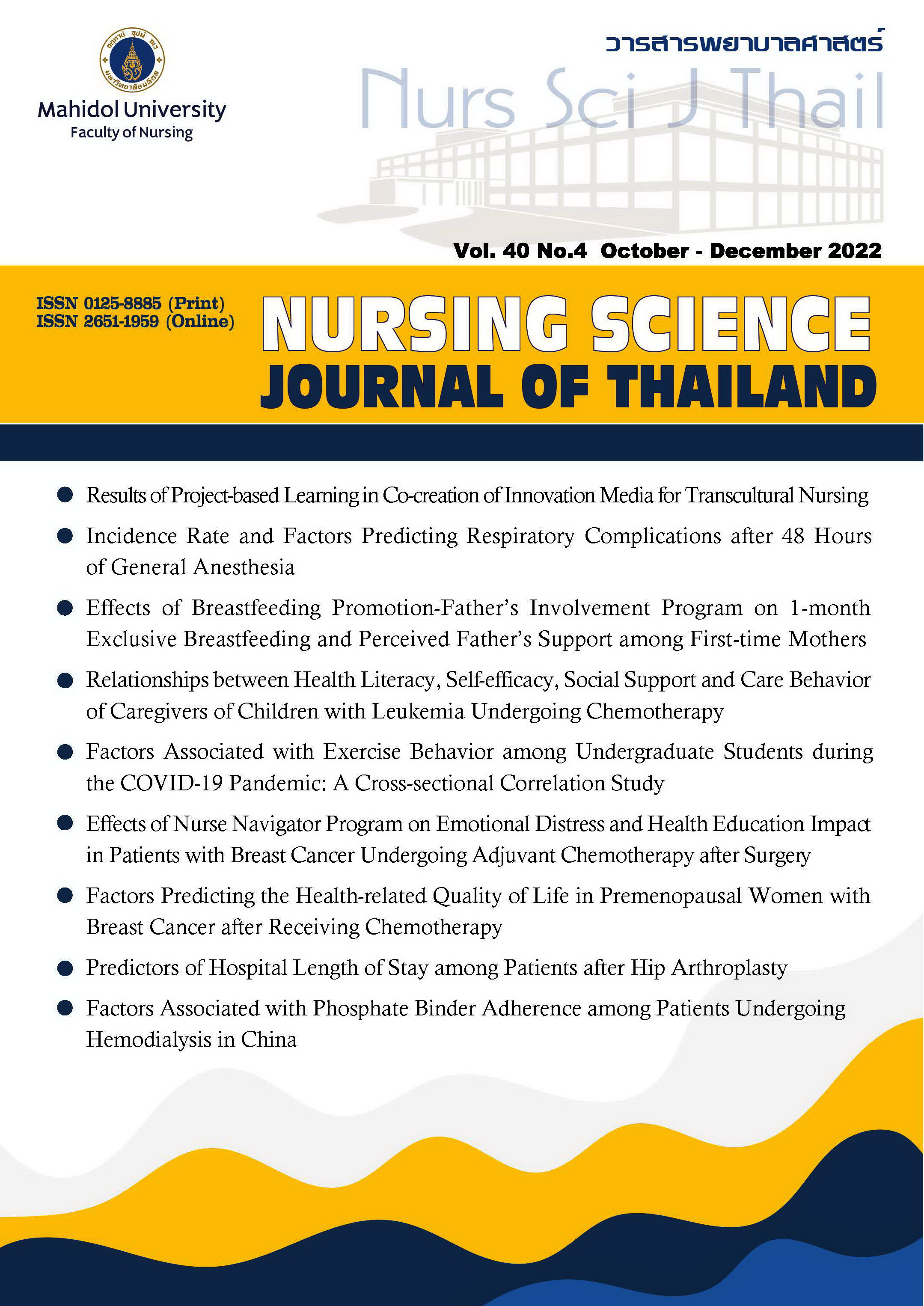Factors Associated with Exercise Behavior among Undergrad Students During The COVID-19 Pandemic A Cross-Sectional Correlation Study
Main Article Content
Abstract
Purpose: The objective of this study was to examine the relationship between body mass index, income, health perceptions, and exercise behavior among undergraduate students during the COVID-19 pandemic.
Design: A cross-sectional correlation study.
Methods: The samples were junior nursing students from a faculty of nursing in one university in the academic year of 2020. The sample size was 110 students who were obtained from simple random sampling. Data were collected by using personal information questionnaire, health perception questionnaires, and exercise behavior questionnaire. Data were analyzed by using descriptive statistics, and Pearson’s product moment correlation coefficient.
Main findings: The results of the study showed that income, body mass index, and perceived benefits of exercise were positively correlated with exercise behavior during the COVID-19 pandemic at significance level .05 (r = .18, p < .05; r = .21, p < .05; and r = .22, p < .05, respectively). Perceived barriers of exercise was negatively correlated with exercise behavior during the COVID-19 pandemic at significance level .05 (r = - .23, p < .05).
Conclusion and recommendations: Perceived benefits of exercise and perceived barriers of exercise were correlated with exercise behavior. Therefore, health care providers and policymakers should promote and support an exercise promoting program for undergraduate students by enhancing their perceived benefits of exercise and self-efficacy in overcoming obstacles to regularly perform exercise even during the COVID-19 pandemic.
Article Details

This work is licensed under a Creative Commons Attribution-NonCommercial-NoDerivatives 4.0 International License.
Copyright Notice: Nursing Science Journal of Thailand has exclusive rights to publish and distribute the manuscript and all contents therein. Without the journal’s permission, the dissemination of the manuscript in another journal or online, and the reproduction of the manuscript for non-educational purpose are prohibited.

Disclaimer: The opinion expressed and figures provided in this journal, NSJT, are the sole responsibility of the authors. The editorial board bears no responsibility in this regard.
References
Belcher BR, Zink J, Azad A, Campbell CE, Chakravartti SP, Herting MM. The roles of physical activity, exercise, and fitness in promoting resilience during adolescence: effects on mental well-being and brain development. Biol Psychiatry Cogn Neurosci Neuroimaging. 2021;6(2):225-37. doi: 10.1016/j.bpsc.2020.08.005.
Topothai T, Liangruenrom N, Topothai C, Suriyawongpaisan W, Limwattananon S, Suriyawongpaisan C, et al. How much of energy expenditure from physical activity and sedentary behavior of Thai adults: The 2015 national health and welfare survey. Journal of Health Systems Research. 2017;11(3):327-44. (in Thai).
Pratanaphon S, Longlalerng K, Jitmana J, Chaikla K, Nankanya T, Pirunsarn U, et al. Content validity and psychometric characteristics of the Thai translated version of the physical activity questionnaire for children (PAQ-C) and adolescents (PAQ-A). Journal of Associated Medical Sciences. 2020;53(3):84-91.
Amornsriwatanakul A, Lester L, Rosenberg M, Bull F. School policies and practices associated with Thai children's overall and domain specific physical activity. PLoS One. 2021;16(1):e0245906. doi: 10.1371/journal.pone.0245906.
Daniel SJ. Education and the COVID-19 pandemic. Prospects. 2020;49(1):91-6.
Center for The Spread of Coronavirus Disease 2019 [Internet]. Bangkok: Ministry of Interior; 2020 [updated 2021 Mar 26; cited 2020 May 15]. Available from: http://www.moicovid.com/ (in Thai).
Government Gazette. Emergency decree on public administration in emergency situation, A.D. 2005. Bangkok: Royal Decree Office; 2020. 9 p. (in Thai).
Piboon K, Methaphat C, Ouppawongsapat D, Chaiklongkit K, Arunrat P, Sukthong N. Predicting factors of physical activity among university students, Thailand. Bangkok Medical Journal. 2020;16(1):33. doi: 10.31524/bkkmedj.2020.11.007.
Tongwat P, Kitreerawutiwong N. Factors predicting physical activity behaviors among grade 4-6 students in Nongkula Sub-district, Bang Rakam District, Phitsanulok Province. Nursing Journal of The Ministry of Public Health. 2019;29(2):24-36. (in Thai).
Arunpraparat B, Wongcharoen C, Ratchadaporn M. Health behavior of the third-year students in Naresuan University. The 12th National Symposium Naresuan Research: Research and Innovation for National Development; 2019 July 21-22; Phitsanulok: Thailand. (in Thai).
Yamane T. Statistics: An introductory analysis. 3rd ed. New York: Harper & Row; 1973. 1130 p.
Polit DF, Beck CT. Nursing research: generating and assessing evidence for nursing practice. 9th ed. Philadelphia: Lippincott Williams & Wilkins; 2012. 802 p.
Yodmalai P, Vongjaturapat N. Personal factors, exercise motivation and exercise behavior of people in Muang District, Chonburi. Journal of Exercise and Sport Science. 2013;10(1):31-47. (in Thai).
Suksai P. Factor influencing on exercise behaviors of students in Naresuan University. Journal of Sports Science and Health. 2013;14(2):99-110. (in Thai).
Khumros W, Mattavangkul C, Thansuk C. Factors affecting exercise behavior of subjects in Phasi Charoen District, Bangkok. Chulalongkorn Medical Bulletin. 2019;1(4):359-68. (in Thai).
Tiautchasuwan Y. Physical activity behavior of Rajapruk University students and related factors. Journal of Safety and Health. 2020;13(2):205-22. (in Thai).
Janz NK, Becker MH. The Health Belief Model: a decade later. Health Educ Q. 1984;11(1):1-47. doi: 10.1177/109019818401100101.
Sanasuttipun W, Nookong A. The factors found capable of predicting the teenage participants’ exercise and activity behaviour. Thai Journal of Nursing Council. 2015;30(2):46-59. (in Thai).
Yeepaloh M. Relationships between beliefs and exercise behaviors among Muslim female adolescents in Islamic private schools in Southern Thailand [master’s thesis]. Songkhla: Prince of Songkla University; 2013. 138 p. (in Thai).


